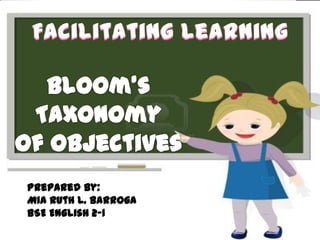
Bloom's taxonomy of Objectives
- 1. Prepared by: Mia Ruth L. Barroga BSE English 2-1
- 2. ►Is a classification of learning objectives within education proposed in 1956 by a committee of educators chaired by Benjamin Bloom ► Created in order to promote higher forms of thinking in education, such as analyzing and evaluating, rather than just remembering facts.
- 3. ►Bloom’s taxonomy divides educational objectives into three types: Cognitive(knowing/head), Affective(Feeling/heart) and Psychomotor(doing/hands) ►Bloom's Taxonomy is considered to be a foundational and essential element within the education community as evidenced in the 1981 survey Significant writings that have influenced the curriculum: 1906- 1981, by H.G. Shane and the 1994 yearbook of the National Society for the Study of Education
- 4. comes in different levels which are knowledge, application, analysis, synthesis and evaluation.
- 6. The students must recall or recognize information: facts, definitions, memorized rules, generalizations, values and skills. Verbs/Keyword: Remember Recognize Recall List State Identify Sample question stems: -Who? -What? -Where? -When? -How? -Who are the…? -What is? Sample Question: Who wrote the Noli Me Tangere?
- 7. The students understand the meaning, translation, interpolation, and interpretation of instructions and problems. State a problem and information in one's own words. Verbs/Keyword: Interpret Translate Summarize Tell Sample question stems: -What do you think could happened next? -Can you provide a definition for…? -In your own words what is …? Sample Question: Based from the article, what is the meaning of the peace?
- 8. The students use a concept in a new situation or unprompted use of an abstraction. Applies what was learned in the classroom into novel situations in the work place. Verbs/Keyword: Apply Use Show Use of facts and principles Problem Solving. Sample question stems: -How is… related to..? -Would this information be useful if…? -Why is.. Significant …? Sample Question: In what events of life can you apply this kind of method?
- 9. The students separate material or concepts into component parts so that its organizational structure may be understood, distinguish between facts and inferences. Verbs/Keyword: Analyze Separate Distinguish, Subdivide Discriminate Point out Compare Sample question stems: -Can you distinguish between…? -Classify … according to … -Make an outline for … -How does …compare/contrast with..? -What are the parts or features of …? Sample Question: What are the comparisons of these two things?
- 10. The students build a structure or pattern from diverse elements. Put parts together to form a whole, with emphasis on creating a new meaning or structure. Creating a unique or original product or proposing alternative solutions. Verbs/Keyword: Combine Compose Construct Revise Synthesize Design Plan Sample question stems: -How many ways can you ….? -What might happen if you combine…? -Can you write a new…? Sample Question: By combining the problems you gathered, can you give a possible solutions to the problem?
- 11. The students make judgments about the value of ideas or materials. Development of opinions or decisions. Verbs/Keyword: Criticize Defend Assess Justify Judge Evaluate Sample question stems: Can you defend your …? What is the most important…? Do you agree…? What do you think about…? Sample Question: Do you think Mrs. Janet Lim-Napoles can be used as state witness? Why or why not?
- 12. As teachers we tend to ask questions in the "knowledge" category 80% to 90% of the time. These questions are not bad, but using them all the time is. Try to utilize higher order level of questions. These questions require much more "brain power" and a more extensive and elaborate answer.
Editor's Notes
- ph
